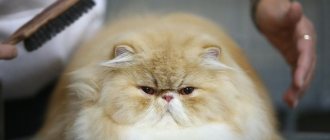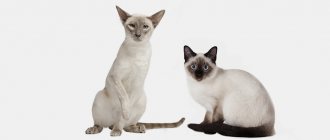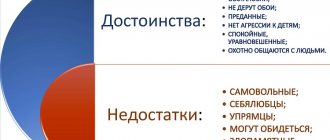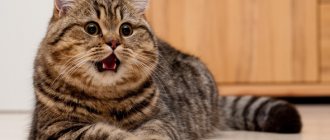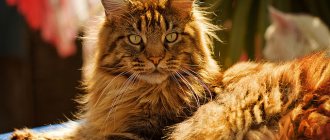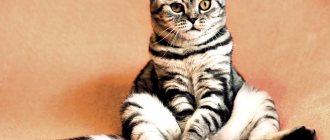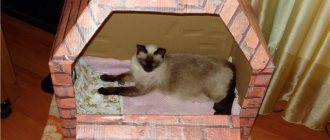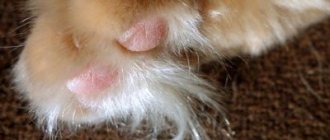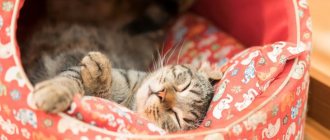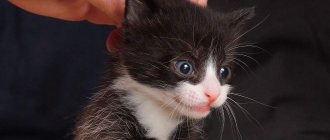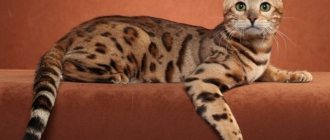Is it possible to crossbreed a Briton and a Scot?
All cat breeds have a common genetic sex pattern and the same number of chromosomes, so they can be bred with each other. In the process of breeding history, the Scottish Fold (low-eared) breed was formed.
Mating between this breed is strictly prohibited. Both partners have a gene for lop ears, which leads to genetic mutations. It was possible to get rid of the defect by crossing Scottish Fold cats with straight-eared British cats.
To maintain the standard of the Scottish breed, it was allowed to breed Britons with Scots, although matings between them were prohibited in the British breed.
The litter belonged to the Scots, they were recorded as:
- Scottish Fold - fold-eared kittens;
- Scottish Straight - individuals with straight ears.
Gradually, the appearance of the Scots began to differ significantly from the British. The ears, body size, length of paws and tail have changed. Unlike British cats, Scottish cats are lighter in bone, smaller in size, have a rounded head with huge eyes, small ears, and long hair. They are harsher in character.
Straight ears are the only difference between the Scottish Straight and the Scottish Fold. The World Cat Federation has registered the Scottish Straight as "Scottish Shorthair". The breed received the right to participate in the championship. To preserve the breed characteristics of the Scots, Folds stopped crossing with the British and started with Scottish Straights.
Kittens born from two British parents are considered British. If other representatives of the breeds participated in the crossing, the breed characteristics deteriorated. As a rule, the color of the British is blue. When crossed with exotics and Persians, the shade of the coat changed to other colors - smoky, black.
Be sure to read:
Lilac British cat: features of the breed’s appearance, characteristics, behavior, care
Description of character
Despite the differences between the British Fold and his ancestors from essentially different breeds, he took the best - incredible friendliness and affection for his owners, balanced disposition and calmness. He loves games, but he never imposes himself, and is also easy to basic training.
To get an obedient pet with a gentle disposition, the owner is required to give up unreasonable aggression and rudeness towards him.
"Lop-eared" becomes attached to the owner
This cat loves to eat, which may be why she quickly becomes attached to the person who feeds her. Therefore, it is advisable that the owner himself does this if he wants to receive devotion and obedience in response to care and affection.
Such a pet is independent and self-sufficient, and is considered an ideal option for a person who is busy at work for a long time.
So, he can remain alone for a long time, but he will always happily meet the person to whom he is attached.
In addition, the cat loves to just sit next to the owner or work with a claw sharpener, and if necessary, he will easily support the game he has started. But at the same time he never sits in his arms and does not tolerate hugs.
Temperament
Like the Scottish Fold, the British Fold is very inquisitive and gentle. Therefore, the maximum that you can get from him in case of dissatisfaction is a loud cry and a dissatisfied look.
It is also worth remembering that a long flexible tail is a pet’s special pride, and, in his opinion, always requires careful handling.
The British is clean and always looks respectable, which should also be remembered. That is, you need to be prepared for the fact that it will require constant attention from a person.
He is very independent and independent, requires personal space and respect from people. Without receiving anything, he will begin to show his dissatisfaction, which will lead to problems in mutual understanding.
In general, a cat can be either calm and balanced, or active and restless, which manifests itself in each individual case in its own way.
Pride in such a representative of the family can be combined with playfulness, and gentleness of character with an interest in hunting and tracking down the intended prey.
Relationships with other household members (children and dogs)
The behavior of the Fold remains friendly to everyone; he does not perceive aggression from the outside and does not show it himself. He gets along well with dogs and other pets. He dotes on children, playing with babies and cuddling with them for hours or falling asleep next to the child. Also read the article about the best cat breeds for children.
The main rule here is not to touch the tail and not to offend it in general, otherwise the cat will simply run away, maybe even leave the house.
In some cases, teeth and claws can be used against adults, but such a negative attitude will manifest itself immediately, because they do not know how to harbor a grudge. We recommend reading the article about breeds prone to aggression.
Why do breeders not recommend breeding British and Scottish dogs?
British cats are large in size. The gene responsible for their body weight is strong and is inherited. Kittens are born large. The cat’s skeletal system is not able to adapt to large sizes, and childbirth is difficult and with complications.
Mixing breeds causes various diseases that affect the health of the animal:
- Interbreed mix is prone to obesity. Excess weight disrupts the functioning of the urinary system, pyelonephritis and urolithiasis develop.
- Metis suffer from inflammation of the joints , their limbs become deformed, they hurt greatly, and they practically stop moving. This happens because British cats have a powerful body and wide bones, while Scottish cats have weak ligaments.
- Ear diseases are caused by the lop ear gene. It affects the ear cartilage, and your pet often has ear pain. To get rid of pain, the cat constantly scratches them, causing a secondary infection, which leads to inflammation.
Correct content
When purchasing a cat, you need to immediately determine in what conditions you plan to keep it: exclusively indoors or with access to the street. The best option is when your pet is adapted to different environments.
If the cat is used to constantly being indoors, then it is better not to start walking it, and if necessary, to be examined by a veterinarian, carry it in a carrier. Otherwise, it can lead to stress for the animal.
Your pet should have its own bowls, bed, tray, scratching post, and comb. It is recommended to place the sleeping place and tray in quiet places where no one will disturb him.
When is it possible to crossbreed a Briton and a Scot?
You can match a Brit with a Scot when:
- it is necessary to bring out new features in appearance;
- improve color.
Such matings are called experimental and are carried out in a nursery under the supervision of specialists who carefully study the litter.
Since during cross-breed mating, babies lose standard traits and have problems with the musculoskeletal system, cat owners are not advised to mate animals of the same breed.
Choosing a pet
Which cat to choose: British or Scottish? It all depends on the preferences of the owners. For a noisy family with children, a Scottish dog is more suitable, but these active animals require attention from the owner. Therefore, if everyone in the family works and is absent for a long time, this lifestyle will be more to the liking of a British woman. Well, and the most important thing is to listen to your heart. Sometimes one kitten can captivate with its charm so that all logical arguments fade into the background. The main thing is to remain responsible and soberly assess your capabilities: whether you can provide the animal with suitable conditions.
Which cats are better: British or Scottish? There is no clear answer to this question. After all, “better” or “worse” are subjective concepts. The main thing is to carefully choose an animal, study its pedigree and exclude the presence of genetic abnormalities, especially when it comes to Scottish cats.
Yandex.RTB RA-272370-2 –>
Scottish Fold cats and cats of this breed are distinguished by their friendliness and sociability - this is expressed in the fact that they are constantly looking for company: either people or other pets. Also, cats of this breed, according to their cat habit, are always loyal and affectionate. When choosing a pure breed kitten, we usually encounter the concept of “kennel”, shrouded in mystery.
Many buyers don't understand what this concept really means.
Despite the fact that for a successful choice of a kitten it is quite important to understand exactly what this means
What types of British cats are there - all colors in pictures
Many of them have existed since the appearance of the breed, and some were obtained more recently as a result of careful selection.
Solid colors
In chocolate Britons, the color of the nose is slightly darker than the coat or matches its color, while in cinnamon, on the contrary , the pinkish-brown nose stands out against the background of the darker coat.
Cats of the Fawn (also called the color of a young fawn) have fur of a warm light beige shade, and the pads of their paws and nose are a delicate pinkish color.
Tortoiseshell colors
This can be a combination of rich colors (black, chocolate or cinnamon) with red, as well as blue (or purple) with cream.
The paw pads are pink or black, and the eyes are copper and gold shades. Cream slippers on the paws or short stripes on the nose are possible.
Color point color
A characteristic feature of this group of colors is a light body color and contrasting dark areas - the muzzle, ears, paws and tail.
Bicolor colors
Tabby colors
Dark stripes stretch along the back all the way to the tail, on the sides there are patterns in the form of curls, the tail and neck are decorated with rings. Colors of this type include marbled on gold and silver, as well as black marbled.
Tiger Tabby (also known as Tabby or "Mackerel") - A longitudinal stripe runs along the line of the spine, from which thin stripes descend on the sides.
Spotted tabby - spots are located on the back and sides, they stand out against a light background. Their shape can be oblong, oval or round.
Sometimes the tail is also spotted or decorated with open rings.
Source
Features of breeds
British and Scottish cats are very popular all over the world, the difference between which is not particularly visible to a non-specialist, but still there are certain differences, and those who want to purchase a representative of a certain breed need to know these features.
Very often, the British Blue cat becomes the standard of choice for the buyer. In fact, she, of course, has nothing to do with the heavenly color, just the exquisite gray color of her coat speaks of her belonging to the breed and “blue blood”. The rather powerful body and indescribable expression of the face become one of the most distinctive features of these cats, because a wide variety of shade combinations are actively coming into fashion to replace the gray color of the coat. For example, in an advertisement for cat food, a very funny tabby kitten is filmed. So, this is also a representative of the British, and much more popular today than the classic British blue cat.
What if you breed a Scottish cat with a British cat?
The Scots and the British don't mix!!! Fold-eared dogs cannot be mated with fold-eared dogs!!! It is forbidden! Dangerous! Deadly dangerous! Well, why do people who have absolutely no knowledge of the breed, genetics, or basic breeding rules try to breed cats! Do you know how difficult the Scottish breed is, what a high mortality rate they have, and how many skeletal anomalies there are. That if you choose the wrong cat, you can produce disabled people?
Tears well up in my eyes when I see Scots in the veterinary clinic with fused vertebrae, with creases and wooden tails, with terrible overbites and underbites...
And all this “work” of unscrupulous and nasty breeders, whose cat is leaking and screaming, and instead of castrating the cat and letting her live in peace, they drag her to the first cat they come across, often of a different breed, and get kittens like these! And then they sell them as “British Folds”, which simply DOESN’T exist! And for infections, someone checks such animals for them; such animals often do not have rabies vaccinations and they have never even seen a veterinary passport.
The British are a CLOSED breed! Breeding them with other breeds is prohibited! Scottish Folds can ONLY be bred with Scottish Straights.
Before breeding a cat, you need to exhibit it at an exhibition, listen to the opinion of an expert, whether the cat corresponds to the breed, whether it has defects and problems that it can pass on to its offspring, and only after receiving a breeding assessment, the cat can be mated not with any cat, but with that which is better than her in type, which will cover all the shortcomings of the cat and pass on only the best to the offspring. The offspring depend on the cat by 50-80%.
Do not torment a cat with childbirth; childbirth does not improve the health of any living creature! Childbirth wears out the body and can be fatal. Empty heats and hormonal drugs are a huge risk of cancer. In cats, due to empty heats, pyometra develops, and this is either death or surgery.
Source: https://www.bolshoyvopros.ru/questions/217985-a-chto-esli-svesti-shotlandskuju-koshechku-s-britanskim-kotom.html
